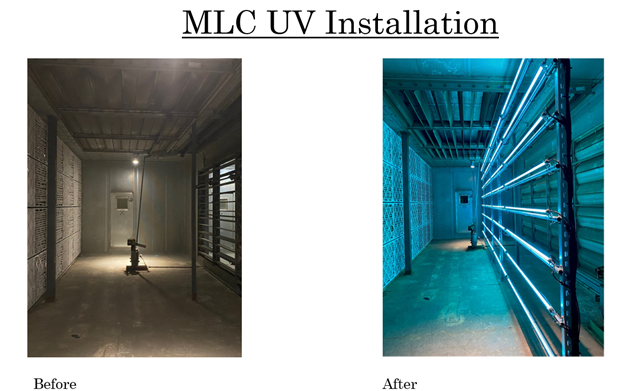Building HVAC
Spring 2022 Update: What is UGA doing to help improve the HVAC ventilation, reliability, and indoor air quality?
UGA is taking active many steps to evaluate and improve HVAC systems on campus. Following CDC, DPH and HVAC industry guidelines. Since our last update we have:
- Updated our interactive project map. Please click here for our interactive HVAC project map for more details about active and planned projects.
- Completed the installation of whole-building UV disinfection devices inside of the HVAC systems at Sanford Hall, Boyd Graduate Research Center, Aderhold Hall, and the Journalism building. These projects bring our campus up to 1.3 Million square feet of highly utilized student spaces protected with UV-C.
- Completed a major HVAC renewal project for the R.C. Wilson building.
- Initiated building recommissioning for 6 buildings and physically started construction for 12 building controls/optimization projects, impacting over 1.4 Million square feet of campus space.
- In partnership with OUA, initiated a major HVAC renewal for Hill Hall, scheduled for this summer.
- Begin the planning and design efforts for significant HVAC renewal projects for FY23, including systems serving nearly 500,000 square feet of research and academic space.
Summer 2021 Update: What is UGA doing to help improve the HVAC ventilation, reliability, and indoor air quality?
- Increased the number of daily air changes in 5.1 Million square feet of campus building space via system operating modifications.
- Installed HEPA filtration in over 50,000 square feet of classrooms.
- Completed over $2 Million of HVAC system replacement projects in the 2020/2021 school year.
- Begun the installation of whole-building UV disinfection devices inside of the HVAC system for 1.3 Million square feet of highly utilized student spaces. Please see our interactive HVAC project map for more details about active and planned UV projects by clicking here.
- Initiated building recommissioning, system replacement, and building controls/optimization projects for over 1.4 Million square feet of campus space. Please see our interactive HVAC project map for more details about active and planned projects by clicking here.
- Completed systems operations checks and preventive maintenance for 1.1 Million square feet of campus space with modernized HVAC systems (newer than 2012) and 2.7 Million square feet of research buildings with high air changes and minimal recirculated air.
What does a whole-building UV disenfection system look like and how does it work?

How does UGA heat, cool, and ventilate buildings?
- Centralized air handler systems (AHU’s)
- Fan Coil Systems
- Window air conditioning units
- Mini-split systems & water source heat pumps
- Variable Refrigerant (VRF) systems
What type of HVAC system is in my building?
What is UGA doing to help improve the ventilation and indoor air quality in my building?
When is Preventive Maintenance scheduled for my building?
What should I expect when Preventive Maintenance is performed?
Can I open building windows?
Can I use wedges or doorstops to keep doors open?
What can you tell me about the filtration units placed in some classrooms?
As part of the larger effort to improve indoor air quality for classrooms, High Efficiency
Particulate Air (HEPA) units have installed in classrooms where other improvement
strategies were not feasible. With over 130 units installed, this effort complements
other initiatives that either increase the daily fresh air changes or improve filtration
for more than five million square feet of academic space. The HEPA filtration systems
are laboratory certified to capture 99.6% of particulates in the air that are the
size of SARS-CoV-2, commonly called COVID-19. The units will filter the air in each
classroom three to four times each hour, depending upon the size of the space. For
more information on the tested performance of these systems, please see the technical report (PDF)for the PuraShield 500 system
